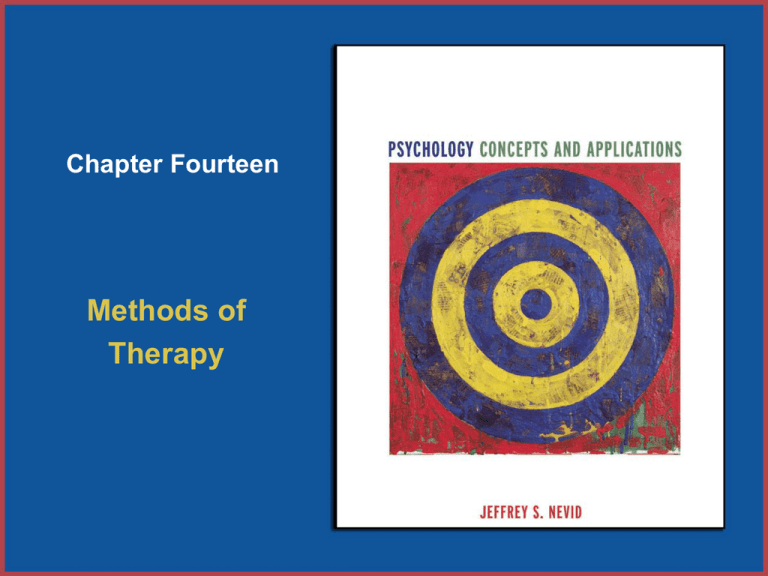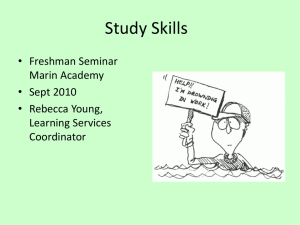
Chapter Fourteen
Methods of
Therapy
Copyright © Houghton Mifflin Company. All rights reserved.
14–1
Did You Know That…
• Sigmund Freud believed that clients bring into
the therapeutic relationship the conflicts they
have had with important persons in their
lives?
• Gestalt therapists have their clients talk to an
empty chair?
• Behavior therapists have used virtual reality
to help people overcome fear of heights?
Copyright © Houghton Mifflin Company. All rights reserved.
14–2
Did You Know That… (cont.)
• Cognitive therapists believe that emotional
problems, such as anxiety and depression,
are caused not directly by troubling events we
experience but by the ways in which we
interpret these events?
• Antidepressant drugs have been used to treat
not only depression but other disorders as
well, such as panic disorder and even
bulimia?
Copyright © Houghton Mifflin Company. All rights reserved.
14–3
Did You Know That… (cont.)
• Stimulant drugs are widely used to improve
attention spans and reduce disruptive
behavior of hyperactive children and
adolescents?
• Sending jolts of electricity through a person’s
head can relieve severe depression?
• In many states, anyone can practice
psychotherapy?
Copyright © Houghton Mifflin Company. All rights reserved.
14–4
Module 14.1
Pathways to the Present: A Brief
History of Therapy
Copyright © Houghton Mifflin Company. All rights reserved.
14–5
Module 14.1 Preview Questions
• How has the treatment of people with
disturbed behavior changed over time?
• What are community-based health centers?
• How successful is the policy of
deinstitutionalization?
Copyright © Houghton Mifflin Company. All rights reserved.
14–6
Moral Therapy
• Philosophy that mentally disturbed people
should be treated with compassion and
humane care.
– Reaction against prevailing view that deranged
people were threats to society.
• Leading proponents
– Jean-Baptiste Pussin & Philippe Pinel
– Dorothea Dix
• Fell out of favor during later half of 19th
century.
Copyright © Houghton Mifflin Company. All rights reserved.
14–7
Community-Based Care
• Community mental health system began in
1960s in response to poor conditions in
mental hospitals.
– Provided alternatives to long-term hospitalization.
• Deinstitutionalization: The social policy that
redirected care from state mental hospitals
toward community-based treatment settings.
Copyright © Houghton Mifflin Company. All rights reserved.
14–8
Community-Based Care (cont.)
• Variety of services offer include:
– Outpatient care
– Day treatment
– Crisis intervention
• Has deinstitutionalization reintegrated mental
patients into their communities?
– Mixed results
Copyright © Houghton Mifflin Company. All rights reserved.
14–9
Module 14.2
Types of Psychotherapy
Copyright © Houghton Mifflin Company. All rights reserved.
14–10
Module 14.2 Preview Questions
• What is psychotherapy?
• What are the major types of mental health
professionals?
• What are the major forms of psychotherapy?
• Is psychotherapy effective?
• What cultural factors do therapists need to
consider when working with members of
diverse groups?
Copyright © Houghton Mifflin Company. All rights reserved.
14–11
What Is Psychotherapy?
• A psychologically based form of treatment
used to help people better understand their
emotional or behavioral problems and resolve
them.
• Called “talk therapy” because consists of a
series of verbal interactions between
therapist and client.
Copyright © Houghton Mifflin Company. All rights reserved.
14–12
Mental Health Professionals
• Clinical psychologists
– Doctoral degree in psychology, licensing exam
– Psychological testing, diagnosing mental
disorders, psychotherapy
• Counseling psychologists
– Doctoral degree in psychology, licensing exam
– Counseling for milder range of problems
Copyright © Houghton Mifflin Company. All rights reserved.
14–13
Mental Health Professionals
• Psychiatrists
– Medical degree, residency
– Physicians specializing in diagnosis and treatment
of mental illness
– May prescribe psychiatric drugs or practice
psychotherapy
Copyright © Houghton Mifflin Company. All rights reserved.
14–14
Mental Health Professionals
• Clinical or psychiatric social workers
– Master’s degree in social work
– Help individuals with severe mental illness to
receive services from community agencies and
organizations
• Psychoanalysts
– Psychologist or psychiatrist with additional training
in psychoanalysis
Copyright © Houghton Mifflin Company. All rights reserved.
14–15
Mental Health Professionals
• Counselors
– Master’s degree in counseling field
– Varied settings and types of counseling
• Psychiatric nurses
– R.N. with master’s degree in psychiatric nursing
– Working with people who have severe
psychological disorders
Copyright © Houghton Mifflin Company. All rights reserved.
14–16
Psychodynamic Therapy
• Based on belief that psychological problems
are rooted in unconscious psychological
conflicts dating from childhood.
• Assumption that gaining insight into conflicts
and working through them are key steps to
restoring psychological health.
• Traditional psychoanalysis developed by
Freud.
Copyright © Houghton Mifflin Company. All rights reserved.
14–17
Traditional Psychoanalytic Techniques
• Free association
• Dream analysis
– Latent versus manifest content
• Interpretation of:
– Resistance
– Transference relationship
– Countertransference
Copyright © Houghton Mifflin Company. All rights reserved.
14–18
Modern Psychodynamic
Approaches
• Less focus on sexual issues
• More focus on
– Adaptive functioning of ego
– Client’s current relationships
• Briefer, more direct approach
Copyright © Houghton Mifflin Company. All rights reserved.
14–19
Humanistic Therapy
• Based on belief that humans possess free will
and ability to make conscious choices.
• Emphasis on the client’s subjective,
conscious experience.
• Focus is on the here-and-now, not the past.
Copyright © Houghton Mifflin Company. All rights reserved.
14–20
Rogers’ Client-Centered Therapy
• Based on belief that psychological problems
stem from blocked self-actualization.
• Focus of therapy is on the person.
– Therapist strives to create warm, accepting
atmosphere for client.
– Nondirective approach.
• Necessary qualities of an effective therapist:
– Unconditional positive regard
– Empathy
– Genuineness
Copyright © Houghton Mifflin Company. All rights reserved.
14–21
Perls’ Gestalt Therapy
• Important to help clients blend conflicting
parts of personality into an integrated whole
or “Gestalt.”
• Characteristics
– Direct, confrontational approach
– Identifying feelings
– Use of role playing, such as empty chair technique
Copyright © Houghton Mifflin Company. All rights reserved.
14–22
Behavior Therapy
• Behavior therapy or behavior modification
• Application of principles of learning to help
person make adaptive changes in behavior.
– Assumption that psychological problems are
learned.
• Focus is on the present situation.
Copyright © Houghton Mifflin Company. All rights reserved.
14–23
Behavior Therapy: Fear Reduction
• Systematic desensitization
– Construction of a fear hierarchy
• Gradual exposure (or “in-vivo exposure”)
• Modeling
• Virtual therapy
Copyright © Houghton Mifflin Company. All rights reserved.
14–24
Behavior Therapy:
Aversive Conditioning
• Form of classical conditioning
• Objects paired with aversive stimuli
– Electric shock, nausea-inducing drug
• Effects often temporary.
Copyright © Houghton Mifflin Company. All rights reserved.
14–25
Figure 14.1:
Model of Aversive Conditioning
Copyright © Houghton Mifflin Company. All rights reserved.
14–26
Other Behavior Therapy Methods
• Operant Conditioning Methods
– Reinforcement and punishment
– Token economy
• Cognitive-Behavioral Therapy (CBT)
– Combines behavioral techniques with cognitive
techniques.
Copyright © Houghton Mifflin Company. All rights reserved.
14–27
Cognitive Therapy
• Focus on helping people change how they
think.
• Assumption that distorted thinking underlies:
– Emotional problems
– Self-defeating behaviors
– Maladaptive behaviors
Copyright © Houghton Mifflin Company. All rights reserved.
14–28
Ellis’ Rational-Emotive
Behavior Therapy (REBT)
• Irrational beliefs lead to problems
– Often take the form of “shoulds” and “musts”
• ABC approach:
– Activating events Beliefs Consequences
• Goal is to recognize irrational beliefs and
replace them with more logical, selfenhancing beliefs.
Copyright © Houghton Mifflin Company. All rights reserved.
14–29
Copyright © Houghton Mifflin Company. All rights reserved.
14–30
Figure 14.2: The Ellis “ABC” Model
Copyright © Houghton Mifflin Company. All rights reserved.
14–31
Beck’s Cognitive Therapy
• Goal is to help clients identify and correct
errors in thinking.
– “Cognitive distortions”
• Clients given homework assignments.
– E.g., Reality testing
• Although similar to REBT, differs in
therapeutic style.
Copyright © Houghton Mifflin Company. All rights reserved.
14–32
Eclectic Therapy
• Draws upon principles and techniques
representing different schools of therapy.
• Most widely endorsed theoretical orientation.
• Some argue that therapeutic integration is
neither desirable nor achievable.
Copyright © Houghton Mifflin Company. All rights reserved.
14–33
Figure 14.3: Clinical and Counseling Psychologists
Identifying with each theoretical orientation
Copyright © Houghton Mifflin Company. All rights reserved.
14–34
Group Therapy
• People brought together to explore and
resolve problems.
• Advantages over individual therapy
– Less costly
– Helps with interpersonal problems, social skills
– Share coping strategies
• Drawbacks
– No one-on-one attention
– Reluctance to disclose
– Feelings of inhibition
Copyright © Houghton Mifflin Company. All rights reserved.
14–35
Family Therapy
• Helps troubled families learn to communicate
better and resolve their differences.
• Family, not individual is the unit of treatment.
• Individual problems symptomatic of family
system breakdown.
Copyright © Houghton Mifflin Company. All rights reserved.
14–36
Couples Therapy
• Often called marital therapy.
• The couple is the unit of the treatment.
• Goal is to build healthier relationships.
– Acquire more effective communication and
problem-solving skills.
– Resolve power struggles.
• Typically focus on disturbed role
relationships.
Copyright © Houghton Mifflin Company. All rights reserved.
14–37
Figure 14.4:
Effectiveness of Psychotherapy
Copyright © Houghton Mifflin Company. All rights reserved.
14–38
Copyright © Houghton Mifflin Company. All rights reserved.
14–39
Which Therapy Is Best?
• Little difference between kinds of therapy
overall.
• Effectiveness may rely on matching problem
to therapy.
Copyright © Houghton Mifflin Company. All rights reserved.
14–40
What Accounts for
the Benefits of Psychotherapy?
• Interpersonal relationship with therapist
– Therapeutic alliance
• Expectation of improvement
– Self-fulfilling prophecy
– Placebo or expectancy effects
Copyright © Houghton Mifflin Company. All rights reserved.
14–41
Multicultural Issues
•
•
•
•
African Americans
Asian Americans
Hispanic Americans
Native Americans
Copyright © Houghton Mifflin Company. All rights reserved.
14–42
Module 14.3
Biomedical Therapies
Copyright © Houghton Mifflin Company. All rights reserved.
14–43
Module 14.3 Preview Questions
• What are the major types of psychotropic or
psychiatric drugs?
• What are the advantages and disadvantages
of psychiatric drugs?
• What is ECT, and how is it used?
Copyright © Houghton Mifflin Company. All rights reserved.
14–44
Antianxiety Drugs
• Also called minor tranquilizers
• Effects
– Reduces anxiety
– Produces calmness
– Reduces muscle tension
• Effect on GABA receptors
• Examples
– Valium, Librium, Xanax
Copyright © Houghton Mifflin Company. All rights reserved.
14–45
Antidepressants
• Increases availability of neurotransmitters
– Serotonin, norepinephrine
• Major types
– Tricyclics
– MAO inhibitors
– Selective serotonin-reuptake inhibitors (SSRIs)
• Therapeutic benefits for both depression and
anxiety disorders.
Copyright © Houghton Mifflin Company. All rights reserved.
14–46
Antipsychotics
• Sometimes called major tranquilizers
• Treatment for schizophrenia, other psychotic
disorders
• Blocks action of dopamine at receptor sites in
brain
Copyright © Houghton Mifflin Company. All rights reserved.
14–47
Other Psychiatric Drugs
• Mood stabilizers to reduce mood swings
– E.g., Lithium
• Stimulants used to improve attention spans
and reduce disruptive behavior in hyperactive
children.
– E.g., Ritalin, Cylert
Copyright © Houghton Mifflin Company. All rights reserved.
14–48
Evaluating Psychotropic Drugs
• Limitations
– May reduce or control symptoms, but not a cure.
– Does not teach how to resolve problems or
develop necessary life skills.
• Risks of adverse side effects
– E.g., tardive dyskinesia with antipsychotics
• Can lead to psychological or physical
dependence.
Copyright © Houghton Mifflin Company. All rights reserved.
14–49
Evaluating Psychotropic Drugs
(cont.)
• Relapses common when stop taking drugs.
– 15-20% of schizophrenics relapse even when
reliably taking medication.
• May be seen as a “quick fix”
• Useful for temporary relief
– Usually used in tandem with psychotherapy.
Copyright © Houghton Mifflin Company. All rights reserved.
14–50
Other Biomedical Therapies
• Electroconvulsive therapy (ECT) can produce
dramatic relief from severe depression.
• Psychosurgery involves surgically altering the
brain to control deviant or violent behavior.
– Prefrontal lobotomy
– Newer more specified techniques rarely used as a
last resort.
Copyright © Houghton Mifflin Company. All rights reserved.
14–51
Module 14.4
Application: Getting Help
Copyright © Houghton Mifflin Company. All rights reserved.
14–52
Module 14.4 Preview Question
• What steps can people take to find qualified
mental health professionals?
Copyright © Houghton Mifflin Company. All rights reserved.
14–53
Choosing a Therapist
• Seek recommendations from respected
sources.
• Seek a referral from a local medical center or
local community mental health center.
• Seek consultation from college counseling
center or health services
• Contact professional organizations for
recommendations.
Copyright © Houghton Mifflin Company. All rights reserved.
14–54
Choosing a Therapist (cont.)
•
•
•
•
Use Yellow Pages, but be wary.
Check for proper licensing
Ask about type of therapy being provided.
Ask about provider’s background and
experience.
Copyright © Houghton Mifflin Company. All rights reserved.
14–55
Working with Therapist
• Discuss diagnosis and treatment plan before
committing.
• Ask about costs and insurance.
• Find out about late/missed session policy.
• If medication is to be prescribed, inquire
about delay, side effects.
Copyright © Houghton Mifflin Company. All rights reserved.
14–56
Working with Therapist (cont.)
• Openly discuss concerns about treatment.
• Request a second opinion if in doubt.
• Be wary of online therapy services.
Copyright © Houghton Mifflin Company. All rights reserved.
14–57







